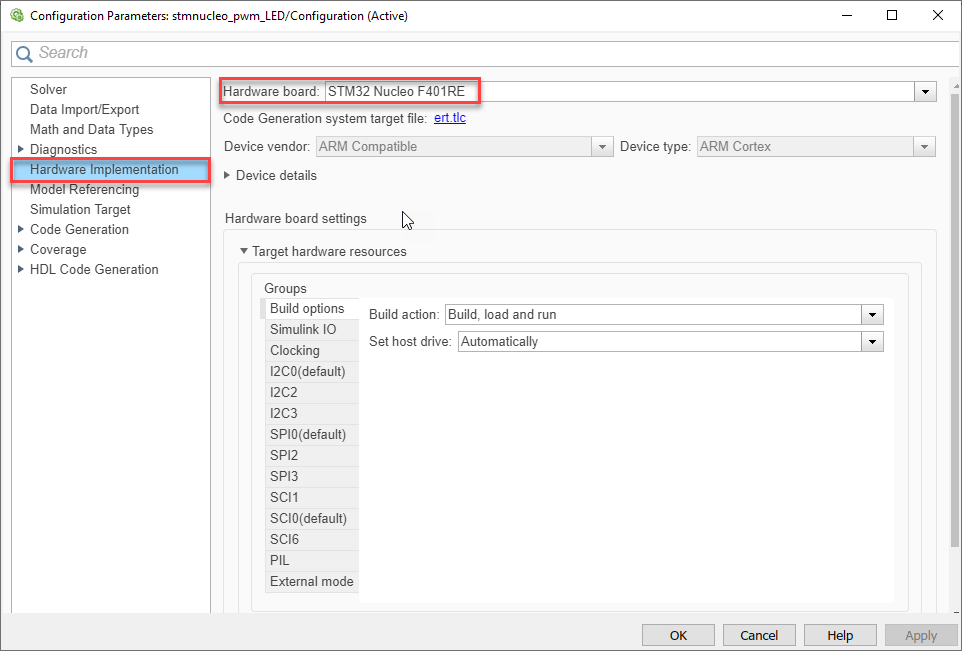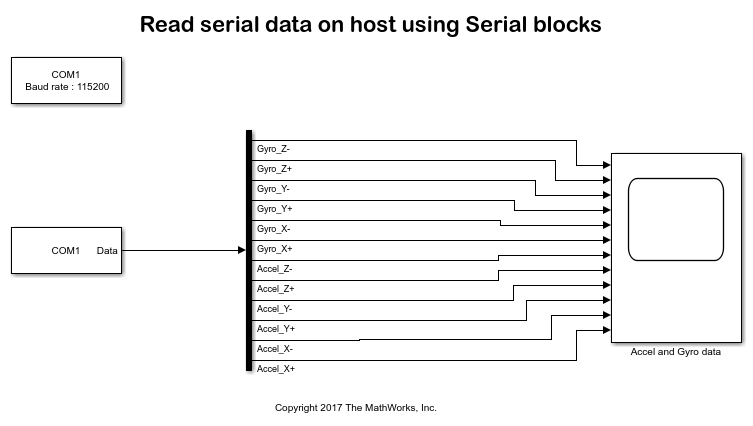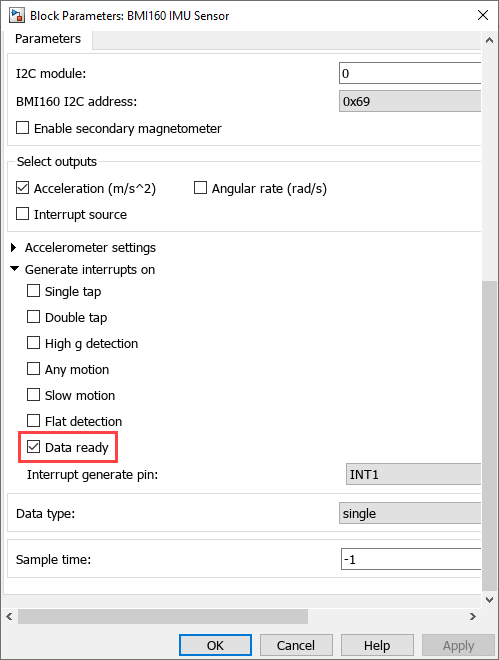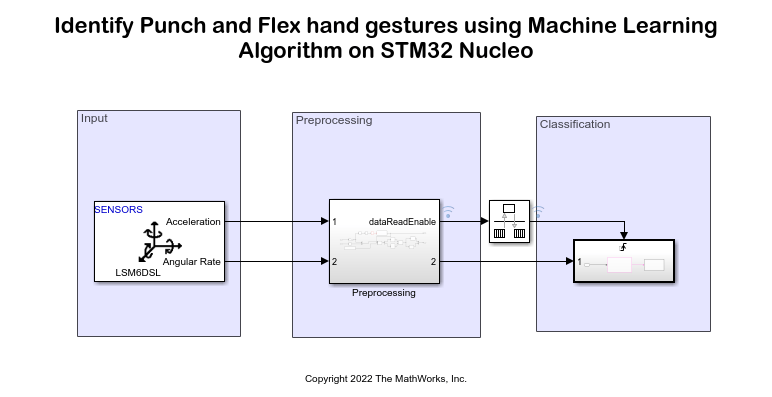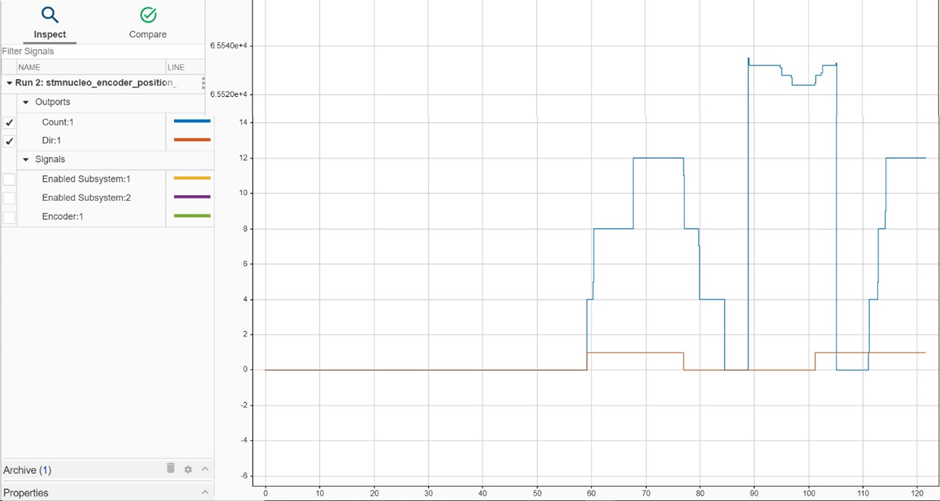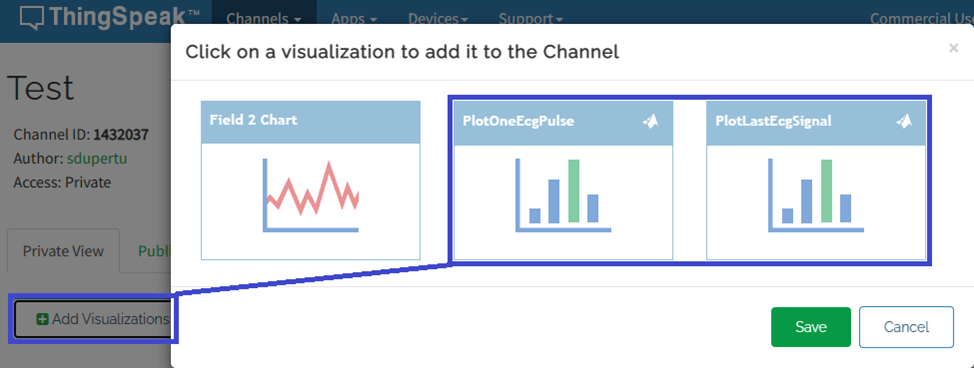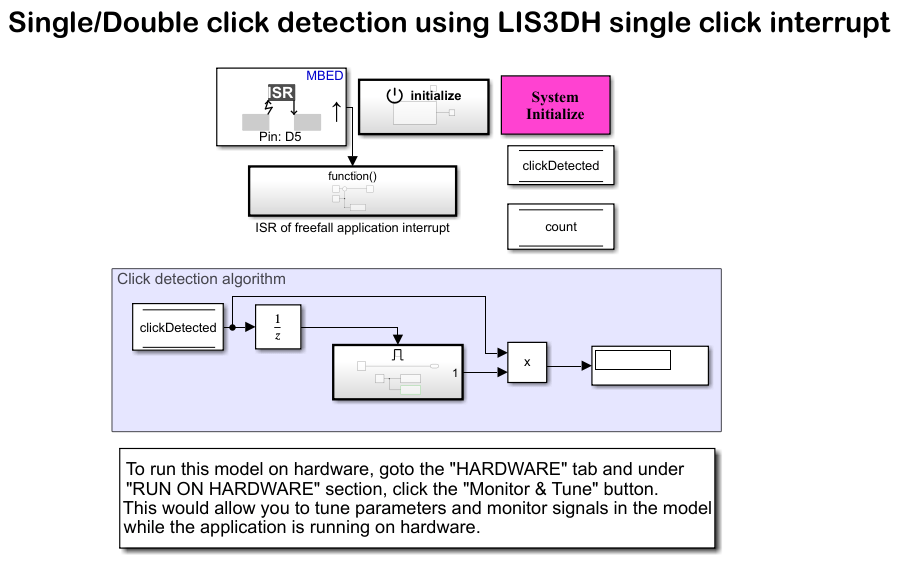建模
准备 Simulink® 模型以进行硬件连接,添加模块以支持硬件协议,并浏览各种应用情形的参考示例。
模块
| Analog Input | Measure voltage of analog input pin |
| Analog Output | Generate voltage on the specified analog output pin in volt (V) (自 R2023a 起) |
| Digital Read | 读取数字输入引脚的逻辑状态 |
| Digital Write | 设置数字输出引脚的逻辑状态 |
| External Interrupt | Trigger the downstream function-call subsystem from an Interrupt Service Routine (自 R2021a 起) |
| I2C Controller Read | Read data from I2C Peripheral devices or I2C Peripheral devices register |
| I2C Controller Write | Write data to I2C peripheral devices or I2C peripheral devices register |
| PWM Output | Generate square wave on the specified output pin |
| SCI Read | Read N-by-1 array of data on UART |
| SCI Write | Send N-by-1 array of data to UART |
| SPI Controller Transfer | Write data to and read data from SPI peripheral devices |
| SPI Register Read | Read data from SPI peripheral devices register |
| SPI Register Write | Write data to registers of SPI peripheral devices |
| Modbus RS485 Client Read | Client device reads data from server device register(s) over RS485 network (自 R2021b 起) |
| Modbus RS485 Client Write | Client device writes data to server device register(s) over RS485 network (自 R2021b 起) |
| Modbus RS485 Server Read | Server device reads data from the server device register over RS485 network (自 R2021b 起) |
| Modbus RS485 Server Write | Server device writes data to server device register over RS485 network (自 R2021b 起) |
| HTS221 Humidity Sensor | Measure relative humidity and temperature from HTS221 sensor (自 R2021b 起) |
| LIS3MDL Magnetometer Sensor | Measure magnetic field strength and temperature from LIS3MDL Magnetometer sensor (自 R2021b 起) |
| LPS22HB Pressure Sensor | Measure barometric air pressure and temperature from LPS22HB sensor (自 R2021b 起) |
| LSM6DSL IMU Sensor | Measure linear acceleration, angular rate, and temperature from LSM6DSL sensor (自 R2021b 起) |
| ADXL34x Sensor | Measure linear acceleration along axes of ADXL34x family of accelerometers (自 R2022a 起) |
| BMI160 IMU Sensor | Measure linear acceleration, angular rate, and temperature from BMI160 sensor (自 R2023a 起) |
| VL53L0X Time of Flight Sensor | Measure distance to a target object (自 R2023a 起) |
| LIS3DH Accelerometer Sensor | Measure linear acceleration, voltage, and temperature from LIS3DH sensor (自 R2023b 起) |
| CCS811 Air Quality Sensor | Measure equivalent CO2 (eCO2) and the equivalent total volatile organic compound concentration (eTVOC) (自 R2023b 起) |
| CAN Receive | Receive message from CAN network (自 R2021b 起) |
| CAN Transmit | Transmit message to CAN network (自 R2021b 起) |
| TCP/IP Receive | Receive data over TCP/IP network from remote host |
| TCP/IP Send | Send data over TCP/IP network to remote host |
| ThingSpeak Read | Read data stored in ThingSpeak channel (自 R2021b 起) |
| ThingSpeak Write | Publish data to Internet of Things using ThingSpeak (自 R2021b 起) |
| UDP Receive | Receive UDP packets from UDP host |
| UDP Send | Send UDP packets to UDP host |
| CAN Read | Read message from CAN network |
| CAN Write | Write message to CAN network |
| TCP/IP Receive | Receive data over TCP/IP network from remote host |
| TCP/IP Send | Send data over TCP/IP network to remote host |
| ThingSpeak Read | Read data stored in ThingSpeak channel (自 R2021b 起) |
| ThingSpeak Write | Publish data to Internet of Things using ThingSpeak (自 R2021b 起) |
| UDP Receive | Receive UDP packets from UDP host |
| UDP Send | Send UDP packets to UDP host |
| Byte Pack | Convert input signals to 8-, 16-, or 32-bit vector |
| Byte Unpack | Unpack 8-, 16-, or 32-bit input vector to multiple output vectors |
| Byte Reversal | Reverse little-endian data for big-endian processor |
| Memory Copy | Copy to and from memory section |
| Protocol Encoder | Encode input data into a uint8 byte stream by specifying the packet structure (自 R2023a 起) |
| Protocol Decoder | Decode a uint8 byte stream by specifying the packet structure (自 R2023a 起) |
主题
- Signal Monitoring and Parameter Tuning over XCP on Serial and TCP/IP
Use your host computer to monitor and control an application running on the target hardware.
- Communicate with Hardware Using Connected IO
Get peripheral data from the hardware before deploying the Simulink model on the hardware.
- Usage of Alternate Pin Names
Accessing multiple hardware peripherals connected to the same pin using alternate pin names.
疑难解答
Workaround for Interrupt Workflow with Sensors
This topic helps you with the workaround for interrupt workflow in sensors.
精选示例
Getting Started with Simulink Coder Support Package Using STMicroelectronics Nucleo Boards
Demonstrates how to use the Simulink® Coder™ Support Package for STMicroelectronics® Nucleo Boards to run a Simulink® model on an STMicroelectronics Nucleo board.
Read Data from I2C-Based Sensors Using STMicroelectronics Nucleo Boards
Use the Simulink® Coder™ Support Package for configuring and reading data from an I2C-based sensor using an STMicroelectronics® Nucleo board.
Communicating with an SPI Based EEPROM Using the STMicroelectronics Nucleo Board
Use Simulink® Coder™ Support Package for STMicroelectronics® Nucleo Boards to enable and write to/ read from an SPI based EEPROM.
Change the LED Glow Intensity on STMicroelectronics Nucleo Boards
Demonstrates how to use the Simulink® Coder™ Support Package to run a Simulink model on an STMicroelectronics® Nucleo board to brighten and dim an LED.
Read Accelerometer and Gyrometer Data from an STMicroelectronics Nucleo Board Using SCI Blocks
Use Simulink® Coder™ Support Package to send data to your computer from a STMicroelectronics® Nucleo board and read it using serial (SCI) blocks.
MODBUS RS485 Communication Between Client and Server Devices Using STMicroelectronics Nucleo Boards
Use the Simulink® Coder™ Support Package for STMicroelectronics® Nucleo Boards to implement a MODBUS® RS485 asynchronous, serial communication between MODBUS client and server devices. It also shows the four modes of operation: Client Read, Client Write, Server Read, and Server Write.
Trigger Downstream Function-Call Subsystem Using STMicroelectronics Nucleo External Interrupt Block with Data Ready Event on BMI160 Sensor
Use the Simulink® Coder™ Support Package for STMicroelectronics® Nucleo Boards to trigger a downstream function-call in Monitor and Tune action when a Data ready event occurs on BMI160 sensor using a ST Nucleo External Interrupt block. This example model for monitor and tune simulation, shows the capabilities of the External Interrupt block during data ready event on BMI160 sensor.
Identify Punch and Flex Hand Gestures Using Machine Learning Algorithm on STMicroelectronics Nucleo Boards
Use the Simulink® Coder Support Package for STMicroelectronics® Nucleo boards to identify punch and flex hand gestures using a machine learning algorithm. The example is deployed on an STM Nucleo board that uses an external sensor (LSM6DSL) available in sensor shield (X-NUCLEO-IKS01A2) to identify the hand gestures. The output from the machine learning algorithm, after identifying whether a hand gesture is a punch or a flex, is transmitted to the serial port where 0 represents a punch and 1 represents a flex.
Control Rotary Encoder Knob Using STMicroelectronics Nucleo Board
Use the Simulink® Coder™ Support Package for STMicroelectronics® Nucleo Boards to control a 12-step rotary encoder with a built-in push button.
ECG Signal Processing Using STMicroelectronics Nucleo Board
Use the STM32 Nucleo F767ZI board to process an ECG signal input from an ECG sensor, extract the heart rate in beats per minutes (bpm), and send the ECG signal and heart rate to the ThingSpeak™ internet of things (IoT) analytics platform service.
Single Click and Double Click Detection Using LIS3DH Single Click Interrupt
Use the Simulink® Coder™ Support Package for STMicroelectronics® Nucleo Boards to sense the free-fall of the sensor using the Single Click interrupt of LIS3DH linear accelerometer connected to a STMicroelectronics Nucleo board.
Free-Fall Detection Using LIS3DH Freefall Application Interrupt
Use the Simulink® Coder™ Support Package for STMicroelectronics® Nucleo Boards to sense the free-fall of the sensor using the Inertial freefall application interrupt of LIS3DH linear accelerometer connected to a STMicroelectronics Nucleo board.
Impact Detection Using LIS3DH Inertial Wakeup Interrupt
Use the Simulink® Coder™ Support Package for STMicroelectronics® Nucleo Boards to sense the impact of the sensor using the Inertial wake-up interrupt of LIS3DH linear accelerometer connected to a STMicroelectronics Nucleo board.
Triple-Axis Tilt Calculation Using LIS3DH FIFO Data Ready Interrupt
Use the FIFO data ready interrupt of LIS3DH linear accelerometer connected to a STMicroelectronics® Nucleo board to sense the tilt of the sensor. This is done using a downstream function-call subsystem that reads acceleration values from FIFO buffer sensor.
MATLAB Command
You clicked a link that corresponds to this MATLAB command:
Run the command by entering it in the MATLAB Command Window. Web browsers do not support MATLAB commands.
选择网站
选择网站以获取翻译的可用内容,以及查看当地活动和优惠。根据您的位置,我们建议您选择:。
您也可以从以下列表中选择网站:
如何获得最佳网站性能
选择中国网站(中文或英文)以获得最佳网站性能。其他 MathWorks 国家/地区网站并未针对您所在位置的访问进行优化。
美洲
- América Latina (Español)
- Canada (English)
- United States (English)
欧洲
- Belgium (English)
- Denmark (English)
- Deutschland (Deutsch)
- España (Español)
- Finland (English)
- France (Français)
- Ireland (English)
- Italia (Italiano)
- Luxembourg (English)
- Netherlands (English)
- Norway (English)
- Österreich (Deutsch)
- Portugal (English)
- Sweden (English)
- Switzerland
- United Kingdom (English)


